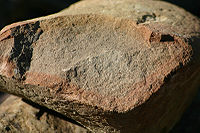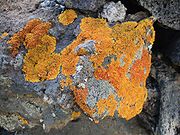Dissolution
This is a type of Chemical weathering. When gases such as sulphur dioxide and nitrogen oxides made by volcanic eruptions and fossil fuels are in the atmosphere. It causes acid rain with the pH of 4.5 or even 3.0. When the acid rain comes down it makes solution weathering to the rock. This process speeds up when the temperature is dropping. The reaction of carbonation a large feature of glacial weathering follows: carbon dioxide+water->carbonic acid carbonic acid+calcium carbonate->calcium bicarbonate.
Hydration
When the mineral sucks up water the increased mass creates physical stresses in the rock. The type of weathering involves a rigid attachment of H+ and OH- ions to atoms and molecules of minerals. For example the hydration of anhydrite forms gypsum.
Hydrolysis and Silicate Weathering
Hydrolysis accurs when water and certain solids have a chemical reaction creating solutions. For example salt and water combines to make ions in solution and a mild acid in solution.Silicate weathering is very similar except that carbon dioxide is also in the reaction. The carbon dioxide reacts with the water forming a weak acid and hydrogen ion donor. This hydrolysis reaction is more common and consumes carbonic acid.
Oxidation
Oxidation occurs when oxygen reacts with various metals. The best known example of this is rust which is the oxidation of iron. Rust has a reddish-brown color and crumbles easily. Other metals and minerals oxidize producing different colorations which also crumble easily.
Biological
Plants and animals create chemical weathering by releasing acidic compounds. By the release of chelating compounds, i.e, acids, plants so as to disintegrate aluminium and iron containing compounds in the layers of soil beneath them. In extreme release of chelating compounds can effect surrounding minerals and it may lead to podsolisation of soils.


